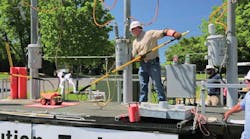Downed power lines don’t always bounce and spark in the street as sometimes depicted in news media clips and Hollywood productions. Often, they lie silent, posing a significant danger for first responders.
Following a storm, when broken poles and damaged or downed wire block the street, firefighters and police officers may put themselves and the public at risk by trying to clear the road. Instead, they should never touch the downed or damaged equipment, but should wait for the responding line crews to test and ground the compromised infrastructure.
While linemen are well versed about the hazards of electricity, first responders are generally not trained how to properly handle a wire down situation. To protect first responders, Duke Energy’s trainers offered six live-line demonstrations in May in western North Carolina. Every year, the utility conducts more than 100 training sessions throughout its territories.
Tree trimmers, county road crews, emergency personnel, firefighters and police officers attended the demonstrations to learn what to do if they encountered damaged or downed power lines. Duke Energy’s trainers require 100 spectators to attend each demonstration, so the utility invites first responders from several different companies and agencies to participate, and then offers the demonstrations at local fire stations or emergency services buildings.
Showing Live-Line Demos
To help educate the first responders before they get unintentionally injured by electricity, Duke Energy set up specialized live-line trailers. For the last 15 to 17 years, Duke Energy Florida, Carolinas East and the Midwest (Indiana and Ohio) have had trailers. Currently, a new trailer is being rolled out in Charlotte, North Carolina, and a second has been constructed for Florida to meet requests within the local communities.
Each trailer includes up to three simulated power poles with transformers and reclosers mounted to the poles. The trailer also features single-phase primary construction, which allows the trainers to short-circuit the wire and create flashes. By pulling an arc, the trainers can simulate what happens when a tree or antenna contacts the primary wire.
Trainers also conduct a demonstration using a firefighter’s boot with a hole in it. When the trainers place the boot in contact with the energized power line, an arc is created near the toe, showing the importance of inspecting and maintaining personal protective equipment (PPE). In the same vein, the trainers also show the first responders the PPE linemen are required to wear while performing their work, including flame-retardant clothing, hard hats, eye protection, hard toe boots, and rubber gloves, as well as specialized tools such as fiberglass work sticks ranging from 6 ft. to 8 ft. dependent upon the voltage being worked.
Duke Energy also educates the first responders about how the utility protects its power lines and equipment from animal invaders, such as squirrels, by installing protective devices to energized parts of equipment and conductors. Another demonstration involves using a toy metal truck to simulate a situation in which a downed wire falls on top of a vehicle. Under these circumstances, they advise the first responders to leave the victims in the car until the power gets turned off. Otherwise, they can unintentionally create a path to ground, leading to a possible electrocution. To show what can happen when electricity travels through the body, the trainers place a damaged rubber glove (pin hole near the thumb) over a hot dog slid onto a metal rod, and then bridge the rod between the primary and neutral conductor, which creates a contact (flash/arc), which would expose the glove wearer to voltage and injury.
Discussion on the dangers of pulling meters is also included in the presentation and cautions first responders not to pull a meter. The trainers advised the frst responders to wait until the lineworker arrives on the scene to turn off the power in a building, because many times, pulling a meter does not turn off the power to a structure.
Engaging the Audience
Because the trainers are working with live electricity, they can’t invite the first responders to actively participate in the demonstrations. The trainers, however, try to involve the spectators in the educational sessions to maintain their interest and increase their learning potential. For example, the trainers pass out a rubber glove to the crowd, and then they ask them to try to spot the hole in it. This can prove to be a diffcult task to the untrained eye. Next, they share an actual fuse and linemen’s tools so the first responders can examine them up close. Following the demonstrations, the trainers answer questions.
One frequently asked question is how far they should stay away from a power line. Duke Energy’s trainers advise them to stay at least 50 ft away from the downed power line because uncontrolled situations, such as a vehicle traveling down the street and striking the wire, could cause it to whip around and contact a first responder.
The audience also often asks, “How hot is the fash when you pull the arc?” and is sometimes surprised to hear that the temperature can reach 9,000°F to 11,000°F — enough to melt metal and hardened steel and seriously injure the body. Finally, the first responders are curious about how a fuse works, and the trainers explain that it is a weak link in the system, and when it works as it should, it will burn in two or open and separate. The trainers educate the first responders that it’s much easier and cheaper to replace the fuse than costly electrical equipment.
Through the demonstrations, Duke Energy aims to educate the first responders about the dangers of electricity. Rather than simply handing them out a brochure about electrical hazards, the utility hopes the live-line sessions will have a lasting impact on them when they encounter a downed line.
John Wingfield ([email protected]), a senior technical training specialist, has been with Duke Energy for 33 years. He is responsible for the initial formal training of apprentices, providing refresher courses for seasoned journeymen and working with fellow Duke trainers to conduct pre-employment hiring tests. Before joining the training department, Wingfield served as a lineman for 18 years.
Editor’s note: To see a video of what happens when you touch a power line, visit https://illumination.duke-energy.com/articles/what-happens-when-something-touches-a-power-line.


